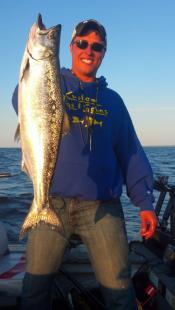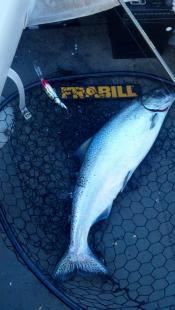 “Bring a jacket, it’s cold out here,” said fellow IDO Pro-staffer Grant Sorenson. Meanwhile, I’m up the hill wiping sweat from my brow while I got ready to meet him only a few short miles away. Like the weather in the greater Duluth, MN area, fishing on Lake Superior isn’t always what it seems. Sure it was a weekday, but the landing was dead. A beautiful day on the lake, devoid of much traffic at all. Surely the bite must be off. Fish must not be here yet right? Contrary to the look of things, there were fish to be had, and Grant was having them. After a few short trolling runs before I could make it down to the Lake, Grant was “3-for-5.” Trout and Salmon-speak for three Coho’s made it boat-side. Pretty darned good from my perspective, especially for only being out a bit. Then I climbed in the boat.
“Bring a jacket, it’s cold out here,” said fellow IDO Pro-staffer Grant Sorenson. Meanwhile, I’m up the hill wiping sweat from my brow while I got ready to meet him only a few short miles away. Like the weather in the greater Duluth, MN area, fishing on Lake Superior isn’t always what it seems. Sure it was a weekday, but the landing was dead. A beautiful day on the lake, devoid of much traffic at all. Surely the bite must be off. Fish must not be here yet right? Contrary to the look of things, there were fish to be had, and Grant was having them. After a few short trolling runs before I could make it down to the Lake, Grant was “3-for-5.” Trout and Salmon-speak for three Coho’s made it boat-side. Pretty darned good from my perspective, especially for only being out a bit. Then I climbed in the boat.
 Not 15-minutes into our run, 2 fish were hooked up almost simultaneously, and only a short time later, yet another. With my luck however, team Sorenson/Nelson was quickly 0-for-3, and not much of a reason behind it. Yet another fish was pro-released for being a bit on the short-side. Either way, they were there and for the taking. Lots of fish on the graph all over the water-column, mostly in that 60FOW range, but we didn’t need to troll anywhere near that deep. Deep Taildancers 120 feet back were what our fish were eating, all on boards that day to keep baits away from the boat in the clear and relatively calm water.
Not 15-minutes into our run, 2 fish were hooked up almost simultaneously, and only a short time later, yet another. With my luck however, team Sorenson/Nelson was quickly 0-for-3, and not much of a reason behind it. Yet another fish was pro-released for being a bit on the short-side. Either way, they were there and for the taking. Lots of fish on the graph all over the water-column, mostly in that 60FOW range, but we didn’t need to troll anywhere near that deep. Deep Taildancers 120 feet back were what our fish were eating, all on boards that day to keep baits away from the boat in the clear and relatively calm water.
 Not being native to the fishery, and quite a few hours away on most days, I was happy to defer to Grant’s extensive experience on the lake regarding color patterns, bait selections, and other trolling minutia. Tuning crankbaits was something I’d done before, but I was surprised to see exactly how often he checked for tune, especially after tangling with a fish. Especially in the big water, a bait that blows out, spins, then comes top-side is almost undetectable. You “lose” a rod in-effect, and worse, take its spot with something that will never turn a fish. Speaking of moving fish, after our initial flurry and a couple later stragglers, the bite slowed quite a bit. Few to no bites in the late afternoon, compounded with the frustratingly full sonar screen, was too much to take. Time to make a change.
Not being native to the fishery, and quite a few hours away on most days, I was happy to defer to Grant’s extensive experience on the lake regarding color patterns, bait selections, and other trolling minutia. Tuning crankbaits was something I’d done before, but I was surprised to see exactly how often he checked for tune, especially after tangling with a fish. Especially in the big water, a bait that blows out, spins, then comes top-side is almost undetectable. You “lose” a rod in-effect, and worse, take its spot with something that will never turn a fish. Speaking of moving fish, after our initial flurry and a couple later stragglers, the bite slowed quite a bit. Few to no bites in the late afternoon, compounded with the frustratingly full sonar screen, was too much to take. Time to make a change.
 Not only did we switch locations, but we started to change out baits more frequently. Each color and/or size would get its 15 minutes of fame, and move to the bottom of the crank box if it didn’t produce. We stayed busy reeling in board rods, modifying rods from boards to snap weights, and generally just threw the book at them. Sometimes the fish stick it to you, and though we had some good action early, it was looking more bleak by the minute as we turned the boat for the final time towards the harbor. I guess that’s all it took, as we both looked back to see the rod surge, yelling in-unison “FISH, FISH, FISH!” Looking straight back behind the boat the planer board looked like a frisbee skipping across the water. “I think it’s a King,” yelled Grant, taking the rod out of the holder while the fish took some serious early runs. I’ve got a camera on him now, trying to both help with the fight, and film at the same time. The board came off pretty well, but took some time, and then the fight was on. 3 serious runs, and we had the fish licked, while I tried to film and net all at the same time. Especially with all of the board rod holders and other junk behind the boat, it was really nice to have Grant’s Frabill Conservation Series Net with the telescoping handle. The big hoop for the nice king, along with that reach made me feel like I could’ve netted that fish from anywhere in the boat! Definitely a worthy addition to any troller’s arsenal.
Not only did we switch locations, but we started to change out baits more frequently. Each color and/or size would get its 15 minutes of fame, and move to the bottom of the crank box if it didn’t produce. We stayed busy reeling in board rods, modifying rods from boards to snap weights, and generally just threw the book at them. Sometimes the fish stick it to you, and though we had some good action early, it was looking more bleak by the minute as we turned the boat for the final time towards the harbor. I guess that’s all it took, as we both looked back to see the rod surge, yelling in-unison “FISH, FISH, FISH!” Looking straight back behind the boat the planer board looked like a frisbee skipping across the water. “I think it’s a King,” yelled Grant, taking the rod out of the holder while the fish took some serious early runs. I’ve got a camera on him now, trying to both help with the fight, and film at the same time. The board came off pretty well, but took some time, and then the fight was on. 3 serious runs, and we had the fish licked, while I tried to film and net all at the same time. Especially with all of the board rod holders and other junk behind the boat, it was really nice to have Grant’s Frabill Conservation Series Net with the telescoping handle. The big hoop for the nice king, along with that reach made me feel like I could’ve netted that fish from anywhere in the boat! Definitely a worthy addition to any troller’s arsenal.
The shadows were long, and light was fading, so we headed back to shore feeling quite a bit better than we did 30 minutes previous. For a few short hours on the big lake, I was happy to take what it would give, and happier yet just to have another day with another species.
Joel
Great report Joel! It’s good to see that not only are Rapala Deep Tail Dancers a great walleye crank bait but also has the ability to put some kings in your boat!
It’s good to see that not only are Rapala Deep Tail Dancers a great walleye crank bait but also has the ability to put some kings in your boat! 
I was just talking to Grant about a lake trout excursion some time in June once my 2100 is full rigged out. That big lake gets in a guy’s blood… one big laker on a good weather day is all it takes.
Grant tells me you took the king home for smoking. Let me know how that turned out.
Nice report Joel!!
Great report. Nice fishing as salmon on that lake can be hard to find.
Grey Beard
Great Report
I get out on Lake Michigan once or twice a year and watching those boards take off skipping is an AWESOME sight!
Darn straight Will, when I was re-telling the story to a buddy, my memory plays back with that board skipping like a well-thrown flat rock!
Good luck when you head up there.
Joel
I’d like to show a pic of how it turned out, but the end-result disappeared before I had a chance to. I use a smoked salmon recipe from Alton Brown, which I’ve come to like over the years. A bit more work than some cures, but like with most of his recipes, you’re well-rewarded in the end. With the smoked salmon we didn’t put out for guests, we made a smoked salmon spread/dip from a chef friend of mine that’s also excellent. Both recipes are below:
Alton Brown’s Smoked Salmon:
Ingredients
1 cup kosher salt
1/2 cup sugar
1/2 cup dark brown sugar
1 tablespoon crushed black peppercorns
2 large salmon fillets or sides, pin bones removed
Directions
In a bowl, mix together salt, sugar, brown sugar and peppercorns. Spread extra-wide aluminum foil a little longer than the length of the fish and top with an equally long layer of plastic wrap. Sprinkle 1/3 of the rub onto the plastic. Lay 1 side of the fish skin down onto the rub. Sprinkle 1/3 of the rub onto the flesh of the salmon. Place second side of salmon, flesh down onto the first side. Use the remaining rub to cover the skin on the top piece. Fold plastic over to cover then close edges of foil together and crimp tightly around the fish.
Place wrapped fish onto a plank or sheet pan and top with another plank or pan. Weigh with a heavy phone book or a brick or two and refrigerate for 12 hours. Flip the fish over and refrigerate another 12 hours. Some juice will leak out during the process so make sure there’s a place for the runoff to gather.
Unwrap fish and rinse off the cure with cold water. Pat salmon with paper towels then place in a cool, dry place (not the refrigerator) until the surface of the fish is dry and matte-like, 1 to 3 hours depending on humidity. A fan may be used to speed the process.
Smoke fish (see Note) over smoldering hardwood chips or sawdust, keeping the temperature inside the smoker between 150 degrees F and 160 degrees F until the thickest part of the fish registers 150 degrees. Serve immediately or cool to room temperature, wrap tightly and refrigerate for up to 3 days.
Smoked salmon spread
Recipe courtesy Tom Linderholm
1 to 1 Smoked salmon to cream cheese
a spoonful of sour cream
salt and pepper (not too much salt)
and the secret is fresh thyme….you can use the dried stuff but fresh is best (a couple sprigs per side of
salmon)
Joel